Three-Airy Beams, Their Propagation in the Fresnel Zone, the Autofocusing Plane Location, as Well as Generalizing Beams
Abstract
:1. Introduction
2. Three-Airy Beams in the Fresnel Diffraction Zone
2.1. Theory
2.2. Experiment
3. Autofocusing Plane of Three-Airy Beams
3.1. Three-Airy Beam Intensity at the Points of the Optical Axis
3.2. Caustic of Three-Airy Beam upon Propagation in the Fresnel Zone
- outside—a triangular-shaped curve (six values for are used),
- inside—a 3-bladed curve with sharp vertices (six values for are used).
4. Fourier Transform of Generalized Three-Airy Beams
- (i)
- When , this formula coincides with Equation (3).
- (ii)
- (iii)
5. Conclusions
Author Contributions
Funding
Institutional Review Board Statement
Informed Consent Statement
Data Availability Statement
Acknowledgments
Conflicts of Interest
Appendix A. Evaluation of the Fourier Image of Three-Airy Beams
Appendix B. Fractional Fourier Transform for Visualization Purposes of a Light Beam Propagation in the Fresnel Zone
References
- Berry, M.V.; Balazs, N.L. Nonspreading wave packets. Am. J. Phys. 1979, 47, 264–267. [Google Scholar] [CrossRef]
- Siviloglou, G.A.; Christodoulides, D.N. Accelerating finite energy Airy beams. Opt. Lett. 2007, 32, 979–981. [Google Scholar] [CrossRef] [PubMed]
- Bandres, M.A.; Gutiérrez-Vega, J.C. Airy-Gauss beams and their transformation by paraxial optical systems. Opt. Express 2007, 15, 16719–16728. [Google Scholar] [CrossRef] [PubMed]
- Sztul, H.I.; Alfano, R.R. The Poynting vector and angular momentum of Airy beams. Opt. Express 2008, 16, 9411–9416. [Google Scholar] [CrossRef] [PubMed]
- Novitsky, A.V.; Novitsky, D.V. Nonparaxial Airy beams: Role of evanescent waves. Opt. Lett. 2009, 34, 3430–3432. [Google Scholar] [CrossRef] [PubMed]
- Torre, A. Airy beams beyond the paraxial approximation. Opt. Commun. 2010, 283, 4146–4165. [Google Scholar] [CrossRef]
- Khonina, S.N. Specular and vortical laser Airy beams. Opt. Commun. 2011, 284, 4263–4271. [Google Scholar] [CrossRef]
- Carvalho, M.I.; Facão, M. Propagation of Airy-related beams. Opt. Express 2010, 18, 21938–21949. [Google Scholar] [CrossRef]
- Dai, H.T.; Liu, Y.J.; Luo, D.; Sun, X.W. Propagation dynamics of an optical vortex imposed on an Airy beam. Opt. Lett. 2010, 35, 4075–4077. [Google Scholar] [CrossRef]
- Bandres, M.A. Accelerating parabolic beams. Opt. Lett. 2008, 33, 1678–1680. [Google Scholar] [CrossRef]
- Bandres, M.A. Accelerating beams. Opt. Lett. 2009, 34, 3791–3793. [Google Scholar] [CrossRef]
- Eichelkraut, T.J.; Siviloglou, G.A.; Besieris, I.M.; Christodoulides, D.N. Oblique Airy wave packets in bidispersive optical media. Opt. Lett. 2010, 35, 3655–3657. [Google Scholar] [CrossRef]
- Vo, S.; Fuerschbach, K.; Thompson, K.P.; Alonso, M.A.; Rolland, J.P. Airy beams: A geometric optics perspective. J. Opt. Soc. Am. A 2010, 27, 2574–2582. [Google Scholar] [CrossRef] [PubMed]
- Barwick, S. Accelerating regular polygon beams. Opt. Lett. 2010, 35, 4118–4120. [Google Scholar] [CrossRef]
- Siviloglou, G.A.; Broky, J.; Dogariu, A.; Christodoulides, D.N. Observation of accelerating Airy beams. Phys. Rev. Lett. 2007, 99, 213901. [Google Scholar] [CrossRef]
- Polynkin, P.; Kolesik, M.; Moloney, J.; Siviloglou, G.; Christodoulides, D. Extreme nonlinear optics with ultra-intense self-bending Airy beams. Opt. Photonics News 2010, 21, 38–43. [Google Scholar] [CrossRef]
- Jia, S.; Lee, J.; Fleischer, J.W.; Siviloglou, G.A.; Christodoulides, D.N. Diffusion-trapped Airy beams in photorefractive media. Phys. Rev. Lett. 2010, 104, 253904. [Google Scholar] [CrossRef] [PubMed]
- Baumgartl, J.; Mazilu, M.; Dholakia, K. Optically mediated particle clearing using Airy wavepackets. Nat. Photonics 2008, 2, 675–678. [Google Scholar] [CrossRef]
- Abramochkin, E.; Razueva, E. Product of three Airy beams. Opt. Lett. 2011, 36, 3732–3734. [Google Scholar] [CrossRef]
- Olver, F.W.J. Asymptotics and Special Functions; Academic Press: New York, NY, USA, 1974; ISBN 148326744X. [Google Scholar]
- Torre, A. Airy beams and paraxiality. J. Opt. 2014, 16, 035702. [Google Scholar] [CrossRef]
- Liang, Y.; Ye, Z.; Song, D.; Lou, C.; Zhang, X.; Xu, J.; Chen, Z. Generation of linear and nonlinear propagation of three-Airy beams. Opt. Express 2013, 21, 1615–1622. [Google Scholar] [CrossRef] [PubMed]
- Izdebskaya, Y.V.; Lu, T.-H.; Neshev, D.N.; Desyatnikov, A. Dynamics of three-Airy beams carrying optical vortices. Appl. Opt. 2014, 53, B248–B253. [Google Scholar] [CrossRef] [PubMed]
- Prokopova, D.V.; Abramochkin, E.G. Three-Airy beams propagated in free space. Bull. Russ. Acad. Sci. 2023, 87, 1773–1778. [Google Scholar] [CrossRef]
- Goodman, J.W. Introduction to Fourier Optics; Roberts & Company: Englewood, CO, USA, 2005; ISBN 0-9747077-2-4. [Google Scholar]
- Abramochkin, E.G.; Razueva, E.V. Elliptic umbilic representations connected with the caustic. arXiv 2020, arXiv:2011.03672. [Google Scholar]
- Khonina, S.N.; Balalayev, S.A.; Skidanov, R.V.; Kotlyar, V.V.; Paivanranta, B.; Turunen, J. Encoded binary diffractive element to form hyper-geometric laser beams. J. Opt. A Pure Appl. Opt. 2009, 11, 065702. [Google Scholar] [CrossRef]
- Papazoglou, D.G.; Efremidis, N.K.; Christodoulides, D.N.; Tzortzakis, S. Observation of abruptly autofocusing waves. Opt. Lett. 2011, 36, 1842–1844. [Google Scholar] [CrossRef] [PubMed]
- Mansour, D.; Papazoglou, D.G. Tailoring the focal region of abruptly autofocusing and autodefocusing ring-Airy beams. OSA Contin. 2018, 1, 104–115. [Google Scholar] [CrossRef]
- Efremidis, N.K.; Chen, Z.; Segev, M.; Christodoulides, D.N. Airy beams and accelerating waves: An overview of recent advances. Optica 2019, 6, 686–701. [Google Scholar] [CrossRef]
- Berry, M.V.; Nye, J.F.; Wright, F.J. The elliptic umbilic diffraction catastrophe. Proc. Phil. Trans. 1979, 291, 453–484. [Google Scholar]
- Nye, J.F. Natural Focusing and Fine Structure of Light; IOP: Bristol, UK, 1999; ISBN 0-7503-0610-6. [Google Scholar]
- Khonina, S.N.; Ustinov, A.V.; Porfirev, A.P. Aberration laser beams with autofocusing properties. Appl. Opt. 2018, 57, 1410–1416. [Google Scholar] [CrossRef]
- Soifer, V.A.; Kharitonov, S.I.; Khonina, S.N.; Strelkov, Y.S.; Porfirev, A.P. Spiral caustics of vortex beams. Photonics 2021, 8, 24. [Google Scholar] [CrossRef]
- Gutiérrez-Cuevas, R.; Dennis, M.R.; Alonso, M.A. Ray and caustic structure of Ince-Gauss beams. New J. Phys. 2024, 26, 013011. [Google Scholar] [CrossRef]
- Vallée, O.; Soares, M. Airy Functions and Applications to Physics, 2nd ed.; Imperial College Press: London, UK, 2010; ISBN 1-84816-548-X. [Google Scholar]
- Abramochkin, E.G. Mellin transform of shifted Airy functions and of their products. Integ. Transf. Spec. Funct. 2024, 35, 189–205. [Google Scholar] [CrossRef]
- Houzet, J.; Faure, N.; Larochette, M.; Brulez, A.-C.; Benayoun, S.; Mauclair, C. Ultrafast laser spatial beam shaping based on Zernike polynomials for surface processing. Opt. Express 2016, 24, 6542–6552. [Google Scholar] [CrossRef] [PubMed]
- Kuchmizhak, A.; Pustovalov, E.; Syubaev, S.; Vitrik, O.; Kulchin, Y.; Porfirev, A.; Khonina, S.; Kudryashov, S.I.; Danilov, P.; Ionin, A. On-fly femtosecond-laser fabrication of self-organized plasmonic nanotextures for chemo- and biosensing applications. ACS Appl. Mater. Interfaces 2016, 8, 24946–24955. [Google Scholar] [CrossRef] [PubMed]
- Zhang, P.; Prakash, J.; Zhang, Z.; Mills, M.S.; Efremidis, N.K.; Christodoulides, D.N.; Chen, Z. Trapping and guiding microparticles with morphing autofocusing Airy beams. Opt. Lett. 2011, 36, 2883–2885. [Google Scholar] [CrossRef] [PubMed]
- Rodrigo, J.A.; Alieva, T. Freestyle 3D laser traps: Tools for studying light-driven particle dynamics and beyond. Optica 2015, 2, 812–815. [Google Scholar] [CrossRef]
- Torre, A. Gaussian modulated Ai- and Bi-based solutions of the 2D PWE: A comparison. App. Phys. B 2010, 99, 775–799. [Google Scholar] [CrossRef]
- Abramowitz, M.; Stegun, I.A. Handbook of Mathematical Functions; Dover: New York, NY, USA, 1972; ISBN 0-486-61272-4. [Google Scholar]
- Gori, F.; Guattari, G.; Padovani, C. Bessel-Gauss beams. Opt. Commun. 1987, 64, 491–495. [Google Scholar] [CrossRef]
- Caron, C.F.R.; Potvliege, R.M. Bessel-modulated Gaussian beams with quadratic radial dependence. Opt. Commun. 1999, 164, 83–93. [Google Scholar] [CrossRef]
- Marston, P.L. Self-reconstruction property of fractional Bessel beams: Comment. J. Opt. Soc. Am. A 2009, 26, 2181. [Google Scholar] [CrossRef] [PubMed]
- Tumkur, T.U.; Voisin, T.; Shi, R.; Depond, P.J.; Roehling, T.T.; Wu, S.; Crumb, M.F.; Roehling, J.D.; Guss, G.; Khairallah, S.A. Nondiffractive beam shaping for enhanced optothermal control in metal additive manufacturing. Sci. Adv. 2021, 7, eabg9358. [Google Scholar] [CrossRef]
- Olver, F.W.J.; Lozier, D.W.; Boisvert, R.F.; Clark, C.W. (Eds.) NIST Handbook of Mathematical Functions; Cambridge University Press: Cambridge, UK, 2010. Available online: http://dlmf.nist.gov (accessed on 24 March 2024).
- Berry, M.V. Stable and unstable Airy-related caustics and beams. J. Opt. 2017, 19, 055601. [Google Scholar] [CrossRef]
- Zannotti, A.; Diebel, F.; Denz, C. Dynamics of the optical swallowtail catastrophe. Optica 2017, 4, 1157–1162. [Google Scholar] [CrossRef]
- Sroor, H.; Moodley, C.; Rodríguez-Fajardo, V.; Zhan, Q.; Forbes, A. Modal description of paraxial structured light propagation: Tutorial. J. Opt. Soc. Am. A 2021, 38, 1443–1449. [Google Scholar] [CrossRef] [PubMed]
- Gori, F.; Santarsiero, M.; Bagini, V. Fractional Fourier transform and Fresnel transform. Atti Fondaz. G. Ronchi. 1994, 49, 387–390. [Google Scholar]
- Alieva, T.; Lopez, V.; Agullo-Lopez, F.; Almeida, L.B. Reply to the comment on the fractional Fourier transform in optical propagation problems. J. Mod. Opt. 1995, 42, 2379–2383. [Google Scholar] [CrossRef]
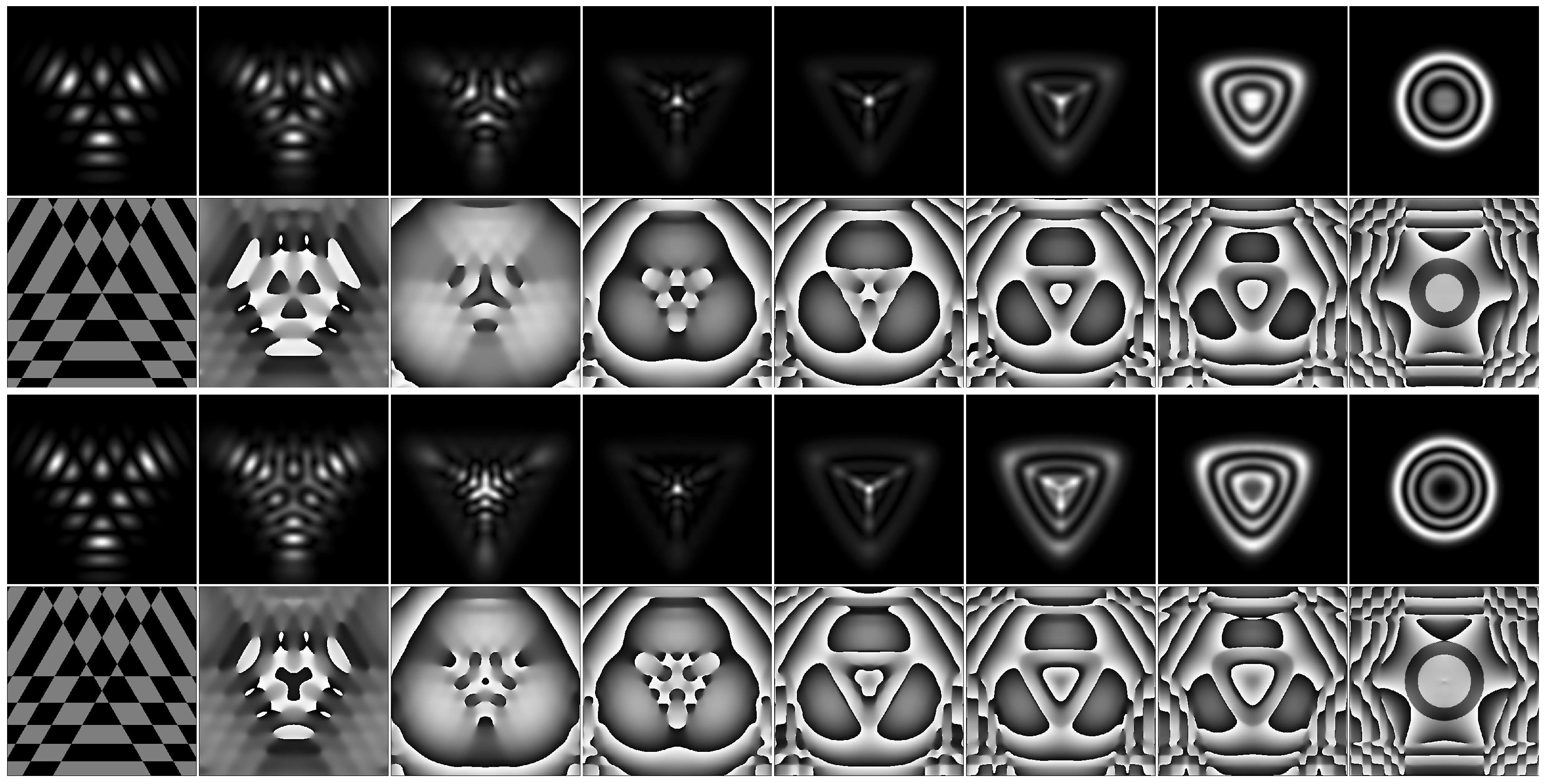


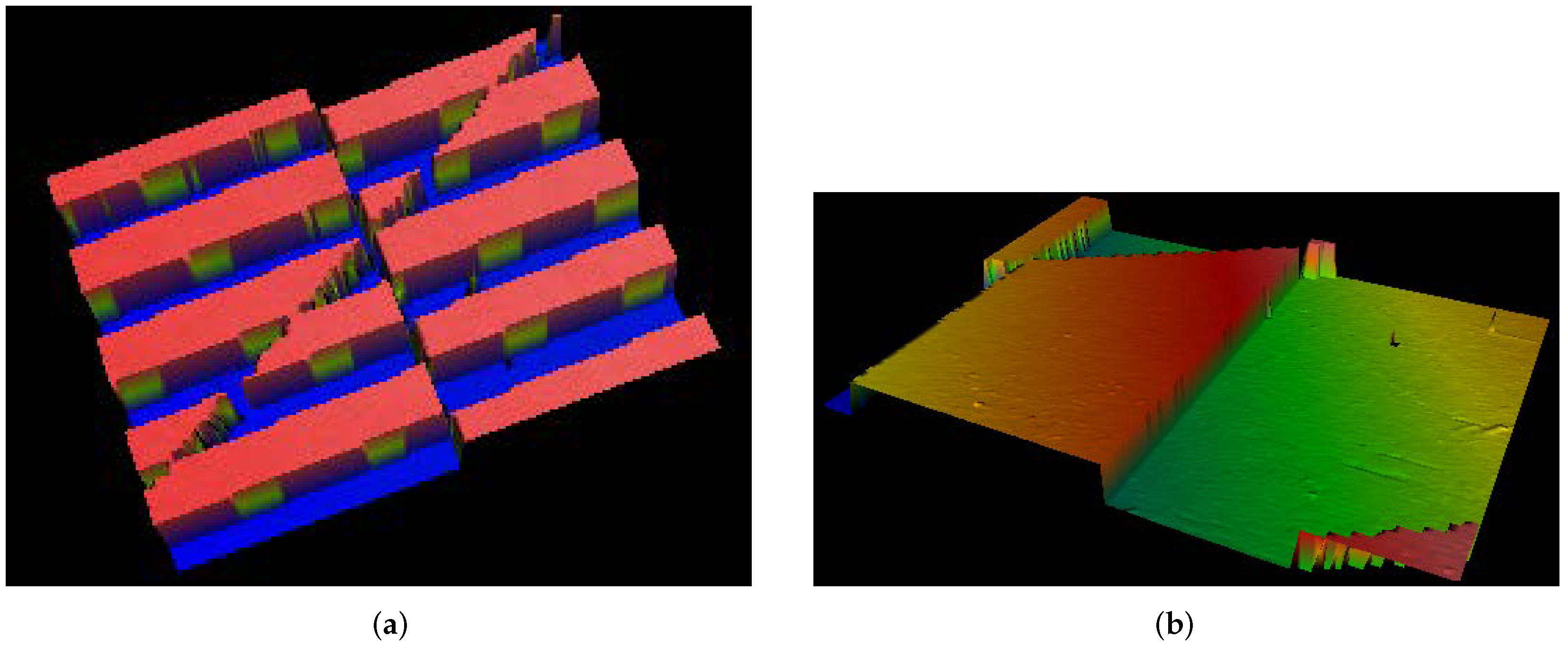
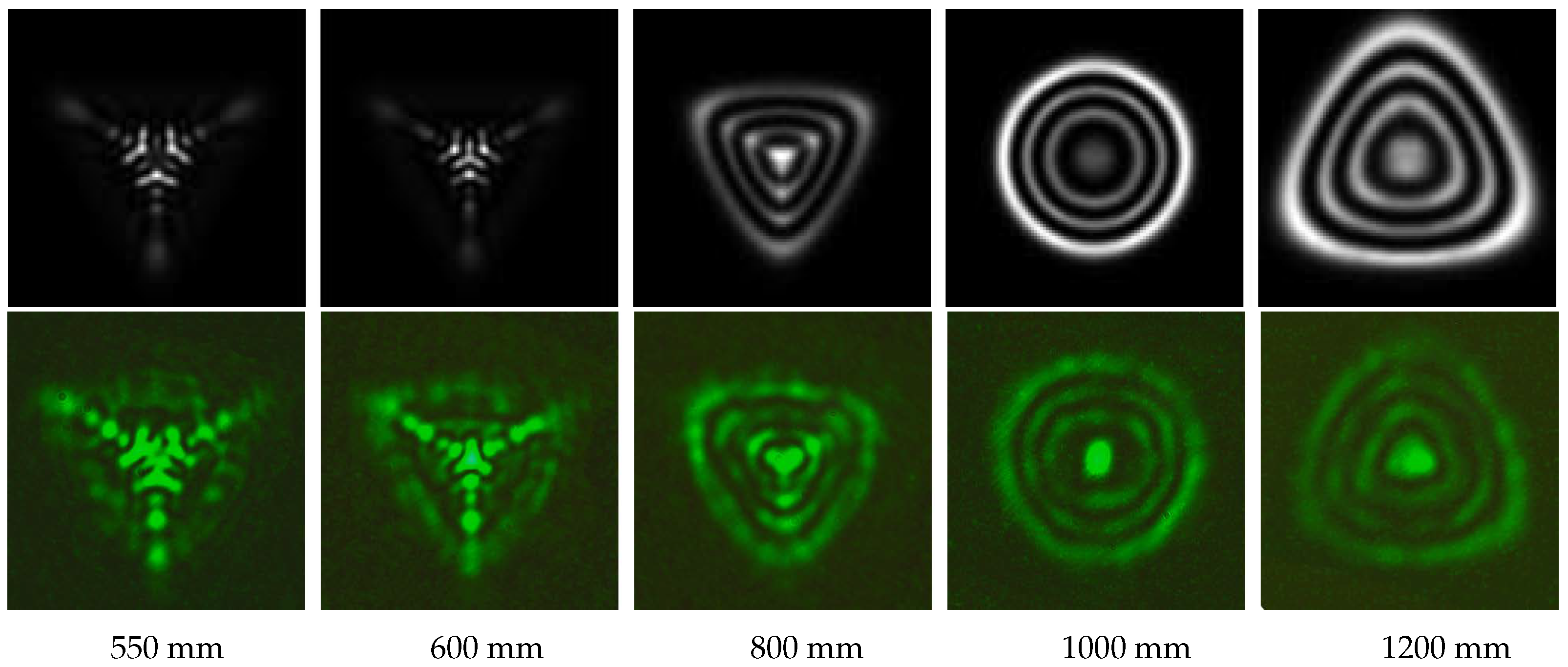
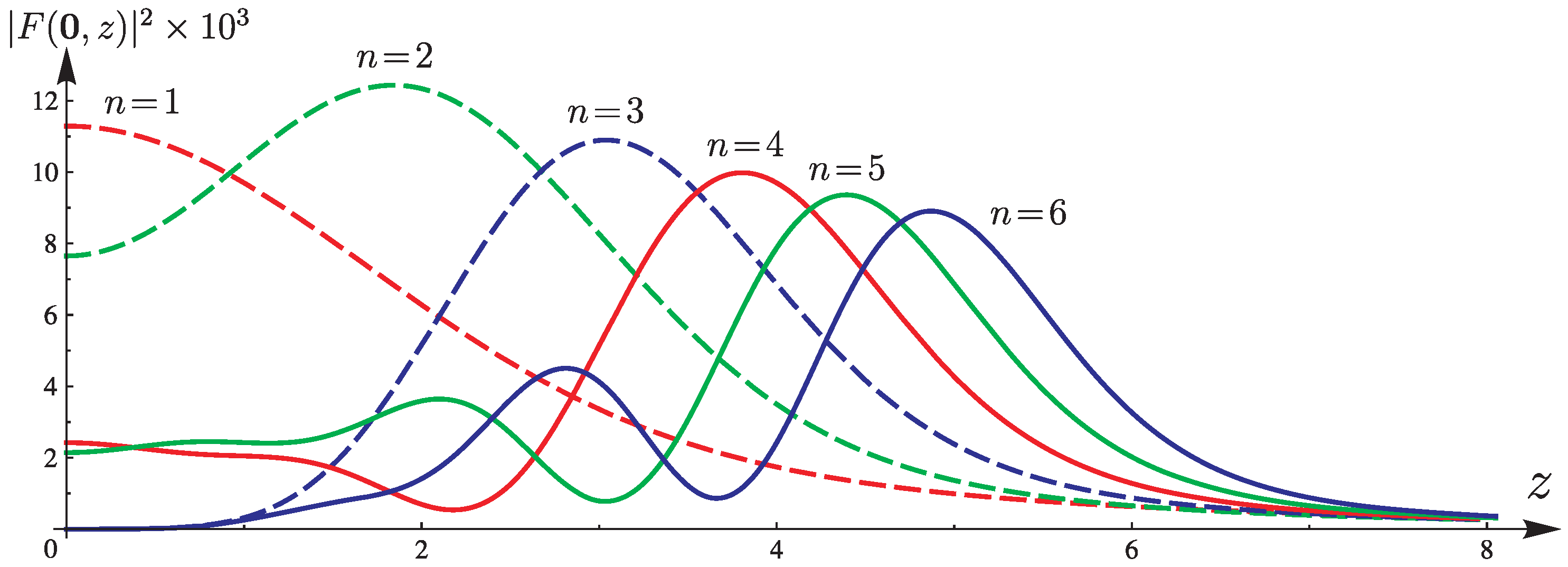



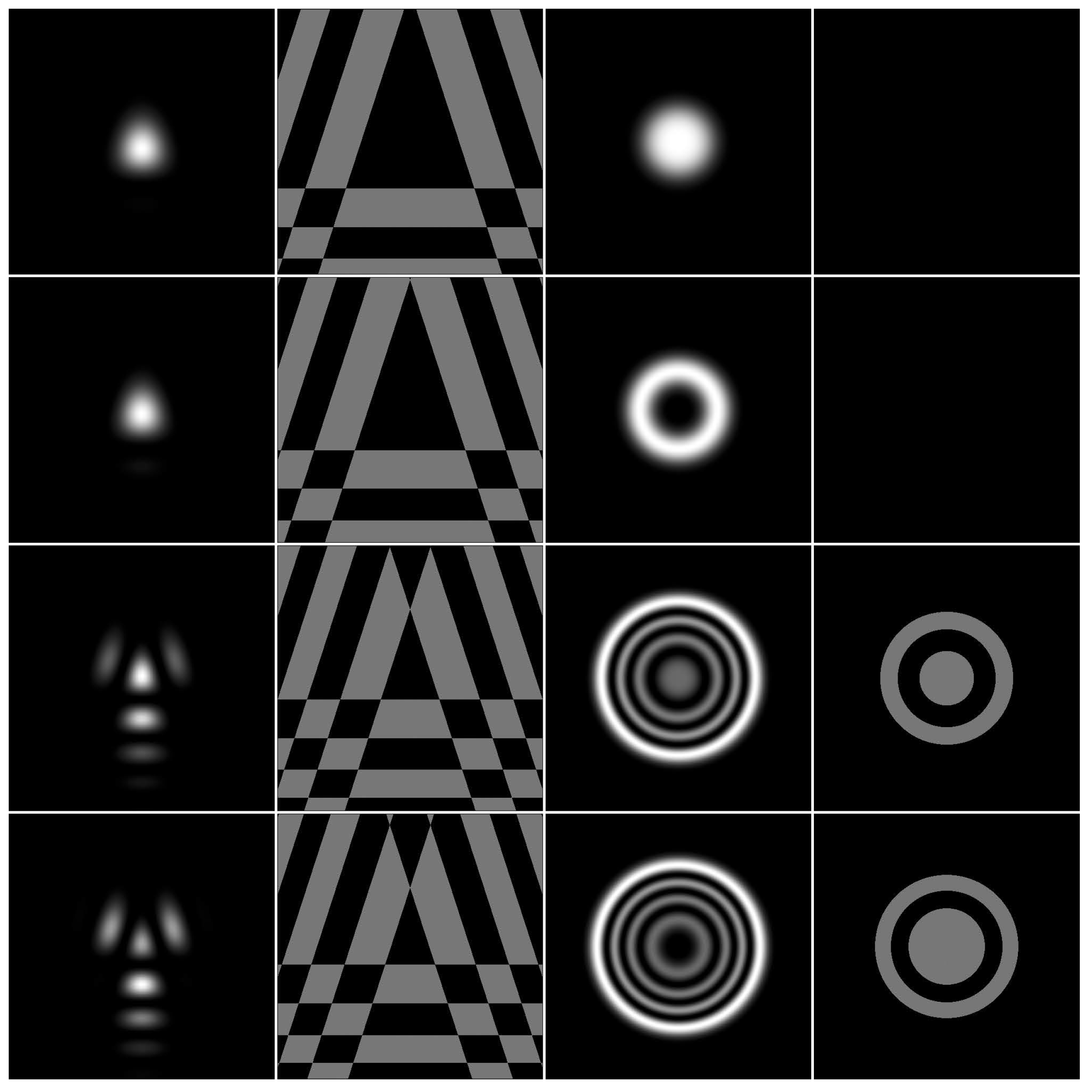
Disclaimer/Publisher’s Note: The statements, opinions and data contained in all publications are solely those of the individual author(s) and contributor(s) and not of MDPI and/or the editor(s). MDPI and/or the editor(s) disclaim responsibility for any injury to people or property resulting from any ideas, methods, instructions or products referred to in the content. |
© 2024 by the authors. Licensee MDPI, Basel, Switzerland. This article is an open access article distributed under the terms and conditions of the Creative Commons Attribution (CC BY) license (https://creativecommons.org/licenses/by/4.0/).
Share and Cite
Abramochkin, E.G.; Khonina, S.N.; Skidanov, R.V. Three-Airy Beams, Their Propagation in the Fresnel Zone, the Autofocusing Plane Location, as Well as Generalizing Beams. Photonics 2024, 11, 312. https://doi.org/10.3390/photonics11040312
Abramochkin EG, Khonina SN, Skidanov RV. Three-Airy Beams, Their Propagation in the Fresnel Zone, the Autofocusing Plane Location, as Well as Generalizing Beams. Photonics. 2024; 11(4):312. https://doi.org/10.3390/photonics11040312
Chicago/Turabian StyleAbramochkin, Eugeny G., Svetlana N. Khonina, and Roman V. Skidanov. 2024. "Three-Airy Beams, Their Propagation in the Fresnel Zone, the Autofocusing Plane Location, as Well as Generalizing Beams" Photonics 11, no. 4: 312. https://doi.org/10.3390/photonics11040312




